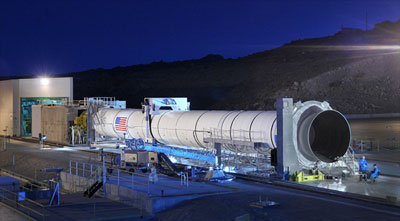ATK today (Sept. 8, 2011) conducted a third successful ground test of the next-generation solid rocket motor. The successful test, known as Development Motor (DM-3), is an important milestone in further validating the rocket's potential use in heavy lift and commercial launch vehicles.
Initial test data indicate the motor performed as designed, producing approximately 3.6 million pounds of thrust, or 22 million horsepower, and burning for just over two minutes.
"This test is the third in a critical series of static tests to evolve and confirm the motor configuration while providing applicable technology maturation for next-generation systems," said Charlie Precourt, vice president and general manager, ATK Aerospace Systems, Space Launch Systems. "This milestone is another step towards completing our Critical Design Technical Interchange activity this fall."
The main test objectives from today's static motor firing were measuring the five-segment rocket's performance and verifying the performance of new materials in the motor joints at hot temperatures. Intentional flaws were introduced in the joint to allow hot gas to penetrate into part of the robust joint to verify joint performance.
DM-3 is the largest human-rated solid rocket motor built today, measuring 12 feet (36.5 m) in diameter and 154 feet (47 m) in length. The five segment motor is based on the space shuttle's four segment boosters, but it's been upgraded to incorporate modern technologies and materials that were not used on the shuttle booster. As a result it produces 30 percent more power than the four-segment motor while utilizing new materials that provide cost and weight savings.
Along with the motor development, ATK has been consolidating its facilities, workforce, and processes to further reduce the cost of producing the solid rocket motors. The five-segment motor was designed to maximize astronaut safety while providing the United States with an affordable and reliable launch capability for both crew and cargo missions.
"The data from these tests, along with information we have collected over the past three decades, confirms this is the most powerful solid rocket motor ever designed," said Precourt. "This performance makes the five-segment a great solution for heavy lift launch vehicles."












